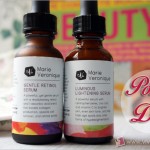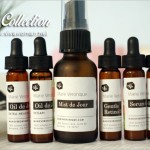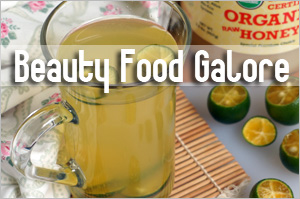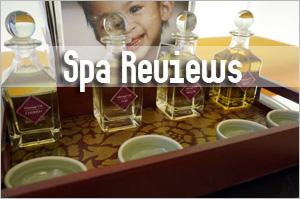
Glucosamine & Niacinamide for anti-aging

If you have read my product review on some of the Marie Veronique Organics products yesterday, you might have noticed two ingredients that I’ve mentioned – Glucosamine and Niacinamide. Both are widely known as health supplements but have increasingly, been included in topical skin care products for their anti-aging properties.
Glucosamine
Glucosamine as most know, is an amino sugar necessary for the construction of healthy connective cartilage and as a supplement, has been proven effective in easing osteoarthritis pain, rehabilitating cartilage, renewing synovial fluid, and repairing joints. However, a study presented by the American Academy of Dermatology in 2006 showed that glucosamine could prove to be an effective topical treatment to reverse the effects of skin cells damaged by UV exposure.
Niacinamide
Niacinamide, also known as Nicotinamide and Nicotinic Acid Amide, is a water-soluble vitamin that is often used as a food additive in many processed foods. It is part of the vitamin B group and there are research supporting practical uses of topical Niacinamide in skin care formulations because of its anti-inflammatory properties. In an article I read from Smartskincare.com, it is mentioned that Niacinamide maybe effective for the treatments of acne and rosacea.
Glusosamine & Niacinamide in reducing hyperpigmentation
In fact, according to an article at CosmeticsDesign.com, it appears that both glucosamine and niacinamide are effective ingredients in reducing hyperpigmentation and improving skin rejuvenation.
Two studies, one on a group of Japanese women aged 25-55 and one on a group of Caucasian women aged 35-65, concluded that N-aceytl glucosamine and N-acetyl glucosamine and niacinamide were more effective in reducing hyperpigmentation compared to a placebo and a nicinamide complex respectively.
Another study supervised by Dr. Kimball, chose 200 subject aged 40-60 with facial hyperpigmentation. The first 100 were given an SPF-15 moisturizing sunscreen lotion and a moisturizing cream with an N-acetyl glucosamine and niacinamide complex, while the other 100 used the same sunscreen and moisturizers without the supplements.
All the subjects were tested for effects of pigmentation and the results showed that there was a clear improvement in the effects of hyperpigmentation in the subjects who had used the supplemented moisturizer and sun screen.
Likewise, the study also tested for the effect of N-acetyl glucosamine and niacinamide in in vitro human skin cultures as well as clinical trials on women aged 35-60 with moderate to fine wrinkles. The study found that “the two complexes stimulated the production of hyaluronic acid, a key process in the rehydration of skin, as well as increased collagen expression. The tests showed that in human subjects the improved hydration brought about by the complexes led to a visible reduction in the fine lines and wrinkle of the women who tested the formulation, particularly in the eye area of the face.”
My experience with the ingredients
Both ingredients in topical anti-aging skin care sounds very interesting but are very new to me. I’ve read quite a bit about Niacinamide in DIY formulations and was quite keen to try it out. So the Marie Veronique products are a good testing platform for me. Glucosamine on the other hand, is totally brand new to me and I’ve only read about it recently. I can’t take it as a supplement but I’m glad that I now have a chance to try out its effectiveness on my skin. However, because I’m not using either exclusively but rather in combination with other ingredients, I can’t comment on their effectiveness as yet. But maybe some of you who have tried them in your DIY formulations can share?
Comments
Leave a Reply
You must be logged in to post a comment.




















iirc olay’s active ingredient is niacinamide? some women (i.e. our grandma’s generation) use it for decades with good results or so i hear. i don’t use it myself but i do like total effects for sensitive skin
I tried my mom’s Oil of Ulan as a kid and it seem quite a good product then. But I still read raves about Olay…certainly didn’t know that they include Niacinamide. Very interesting especially considering Olay’s products are very affordable!
Most products in Olay’s Definity line features the combination of Niacinamide and N-acetyl Glucosamine.
If you want to go the DIY route, might I suggest visiting here
http://www.bulkactives.com/formulations/nagniacinamide.htm
I do visit the website. In fact, I wanted to order Beta Glucan from it but the stock was out.
Niacinamide is a mainstay in my skincare regime. I use Olay White Radiance Intensive Brightening Serum with niacinamide high in its ingredient list, and also use a 4-5% DIY niacinamide toner.
Niacinamide is lovely in DIY preparations because it is highly stable, soluble in water and has a neutral effective pH range around 5-7. Niacinamide increases the ceramide levels in our skin, prevents moisture loss and stimulates microcirculation, which all help to improve the skin’s barrier function. It also has anti-inflammatory properties which can make it useful in treating rosacea (though not all rosacea sufferers can tolerate it) and has been shown to be effective in the treatment of acne at 4% concentration. It helps to fade pigmentation and evens skin tone by inhibiting the transfer of melanosomes to skin cells. It may even have a mitigating effect on tumours. It is also a potent anti-oxidant. (some information taken from skincareman on Make Up Alley)
In short, niacinamide is an anti-oxidant, cell-communicating ingredient that has anti-acne, skin-lightening, anti-ageing and skin barrier-repair effects.
This may all look pretty on paper, but I am convinced of these effects because after using my DIY niacinamide toner and Olay, I have noticed marked differences in my skin. My skin is less easily irritated, more even-toned and firmer. I can now use my retinoids (Stieva-A) daily when they were too irritating and drying for daily use previously. While some people experience flushing (not irritation) initially from use of niacinamide in a concentration of 4%, I had no such reaction.
Some links for more information:
Article on the benefits of niacinamide (vitamin B3): http://www.smartskincare.com/treatments/topical/niacinamide.html. Study on effects of niacinamide on pigmentation: http://grande.nal.usda.gov/ibids/index.php?mode2=detail&origin=ibids_references&therow=496587. Study comparing topical application of niacinamide gel to clindamycin gel for the treatment of acne: http://www.ncbi.nlm.nih.gov/pubmed/7657446?dopt=Abstract. FutureDerm.com spotlight on niacinamide: http://www.futurederm.com/2007/10/30/spotlight-on-niacinamide/ .
I agree cos I finished my vitamin C supplement which contains both Niacinamide and Glucosmine and my skin has never been better. I intend to get Niacinamide to add to my other products too.
Hello, could you please let me know which product is the one in the picture at the top of your post. The ingredietns look just perfect but can’t figure what it is. Many thanks. O
It’s a vitamin C skin lightening supplement by Marie Veronique Organics. Click through the link I gave at the beginning of my entry to read the review.
Hello,
You say that you like natural products. But the picture above of the cream contains kojic acid. I have read that kojic acid is unsafe and has been banned in Japan and other countries so is there other alternatives to get rid of hypergimentation and is Niacinamide effective to have an even skin tone.
Thanks for advice and help
Yes, I’ve said I prefer natural products but not many products are 100% natural…some of them contain lesser toxic ingredients. Koji acid is a natural by-product and is safe in cosmetic at lower %.
http://www.ncbi.nlm.nih.gov/pubmed/21164073
If you’re uncomfortable with koji acid, then niacinamide and vit C are good choices too.
I have psoriatic arthritis and i take glucosamine with condroitine regularly. It is very good for knee pain and other joints. Congratulations for this publication.